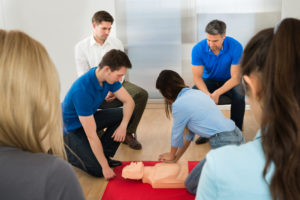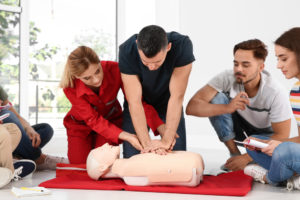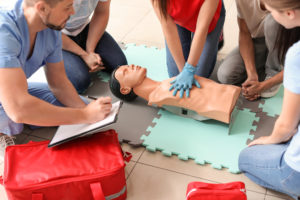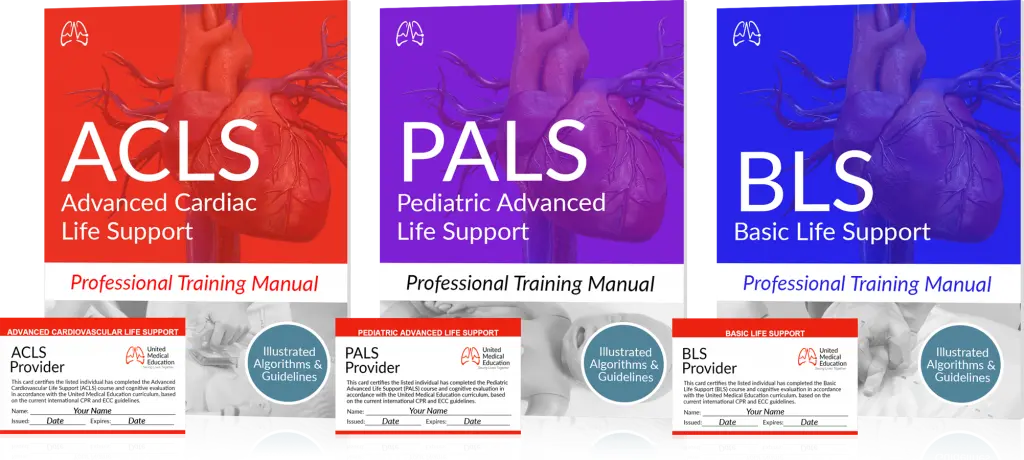My friend Tom has been a lifeguard for a few years now, and there’s one incident that will forever be etched in his memory. One hot summer day, a young girl jumped into the deep end of the pool, only to start struggling seconds later. Tom was quick to respond. He jumped into the pool and performed CPR right there on the poolside. I remember him saying that his training kicked in instantly, and he did everything he’d been trained to do, without even thinking. It was because of his quick response and CPR training that the girl survived.
Lifeguards as Frontline Responders in Aquatic Emergencies
Consider a lifeguard, and most people picture a tanned, fit individual perched on a high chair, scanning a glistening pool with watchful eyes. However, beneath the iconic imagery, lifeguards serve as frontline responders in aquatic emergencies, armed with skills far beyond whistles and rescue buoys. Among these crucial abilities, CPR, AED, and First Aid certification online stand paramount. As gatekeepers of safety, lifeguards equipped with these proficiencies can make a decisive difference in life-threatening situations.
Diving Into the Vital Role of CPR in Water-Related Emergencies
Cardiopulmonary Resuscitation (CPR), a procedure most of us know by name, serves as the frontline defense in cardiac emergencies. It becomes even more vital in water-related crises, where the risk of hypoxia—lack of oxygen—increases dramatically. Lifeguards trained in CPR can deliver chest compressions and rescue breaths, keeping oxygen circulating and buying critical time for more advanced medical intervention.
However, it’s crucial to understand that successful CPR is not merely a product of good intention; it’s a skill honed through rigorous training and certification. Lifeguards are expected to respond instantly and execute CPR efficiently, underlining the need for professional instruction.
Shocking Back to Life
The Crucial Place of AEDs in Cardiac Emergencies at the Pool
Enter the Automated External Defibrillator (AED), a small, portable device capable of delivering a lifesaving shock to the heart. During cardiac arrest, an AED can restore a regular heart rhythm—a procedure critical to survival.
However, the efficacy of an AED is directly linked to the speed and accuracy of its use. Lifeguards, often the first to respond, must be well-versed in operating these devices. Herein lies the critical importance of AED training, equipping lifeguards to deploy these devices confidently, quickly, and correctly when every second counts.
First Aid: An Essential Skill in a Lifeguard’s Toolkit
Besides cardiac emergencies, lifeguards encounter a wide spectrum of situations—from cuts and bruises to serious injuries and allergic reactions. Here, First Aid serves as the primary line of defense. A lifeguard proficient in First Aid can assess the severity of the situation, respond appropriately, and stabilize the individual until further medical help arrives.
Such competence, however, stems from comprehensive First Aid training. This instruction ensures lifeguards are equipped to deal with diverse emergencies, reinforcing their role as frontline responders and highlighting the critical nature of First Aid certification.
The Lifeguard’s Real-World Scenarios: Translating Training to Action
While training scenarios are controlled, real-life situations are anything but. Emergencies can occur at any time, often without warning, testing the lifeguard’s training and adaptability. The transition from learning CPR, AED use, and First Aid techniques in a classroom to applying them in a high-pressure environment is challenging. Therefore, certifications in these skills are more than just qualifications; they’re a testament to a lifeguard’s readiness for real-world scenarios.
Making Waves: The Impact of Lifeguard Training on Aquatic Safety Outcomes
Research corroborates the life-saving potential of CPR, AED, and First Aid skills. Immediate, effective CPR can double, or even triple, survival rates after a cardiac arrest, with survival rates skyrocketing to 70% when an AED is used within the first few minutes.
These statistics underline how a well-trained lifeguard can make a life-altering difference. By successfully performing CPR, accurately deploying an AED, or administering effective First Aid, lifeguards can significantly improve safety outcomes in aquatic environments.
Training Opportunities at United Medical Education
At United Medical Education, we recognize the significance of these skills and offer comprehensive training in CPR, AED, and First Aid. We even provide free PALS (Pediatric Advanced Life Support) training for those who create a student account, demonstrating our commitment to enhancing the skills of lifeguards and other first responders.
The Value of Lifeguard Training with United Medical Education
At United Medical Education, we appreciate the significant role lifeguards play in maintaining safety at our pools, beaches, and water parks. We understand that, as frontline responders, lifeguards carry an immense responsibility on their shoulders. That’s why we’re committed to providing comprehensive, user-friendly, and accessible training in CPR, AED operation, and First Aid to lifeguards everywhere.
Our e-learning platform allows lifeguards to learn these life-saving skills at their pace. Each course is designed to be engaging and interactive, ensuring that you not only learn the theory behind each technique but also understand how to apply them in real-world scenarios. We use a combination of text, images, videos, and quizzes to cater to all learning styles, ensuring that each concept is thoroughly understood and remembered.
In addition to our paid courses, we also offer free Pediatric Advanced Life Support (PALS) training to those who create a free student account. This training, which focuses on managing and responding to emergencies involving children and infants, can be invaluable to lifeguards working in family-friendly environments. We also provide free practice exams to help prepare students for the PALS final exam, ensuring they feel confident and ready to take the test.
Furthermore, we offer regular updates and refresher courses to ensure that your skills stay sharp and up-to-date. We understand that the medical field is continuously evolving, with new research leading to advancements and changes in best practices. As such, we commit to providing you with the most current information and training available.
In Closing: Making a Splash with Lifeguard Training
Being a lifeguard is about more than just watching over swimmers. It’s about being prepared to jump into action and potentially save a life at a moment’s notice. It’s about having the confidence and competence to handle any situation that comes your way. And most importantly, it’s about protecting the safety and well-being of all those who come to enjoy a day of fun in the water.
With the right training and certification in CPR, AED operation, and First Aid, lifeguards can effectively perform their roles, ensuring that everyone can enjoy water activities safely. At United Medical Education, we’re proud to contribute to this goal by providing top-quality, accessible training to lifeguards everywhere.Conclusion: The Lifesaving Power of Lifeguard Training
The image of lifeguards has evolved from mere pool overseers to frontline responders in aquatic emergencies, thanks to their proficiency in CPR, AED usage, and First Aid. Their swift actions, honed by comprehensive training, have an undeniable impact on pool safety and potentially save lives.
United Medical Education is proud to contribute to this process, providing up-to-date, accessible training programs that equip lifeguards with essential skills. Remember, a well-prepared lifeguard is the best prevention.








